“There are three rules for writing. Unfortunately, nobody knows what they are.” – Somerset Maugham.
Despite the fact that there are no rules for writing, there are certainly many “suggestions” on what we can and can not do as writers. Many of those writing maxims will be dealt with in an upcoming post “W is for the Writer’s Rule Book” but in this post I wanted to deal with creating a habit of rule-breaking or questioning advice – once we have the experience and voice to do so.
Questioning a Writing No No : Don’t Begin with a Prologue
 Prologues are so out of favour that it’s hard to find information on what a prologue is in the first place. Quickly – they are –
Prologues are so out of favour that it’s hard to find information on what a prologue is in the first place. Quickly – they are –
A scene in the novel’s front matter – before the first chapter, used to advance information to the reader that they may need to make sense of the story.
Indiana Jones type movies use them a lot, to tell the back-story of the magical artifact Indie will be risking his life for. Prologues are often used in crime fiction: the death of some poor victim from that person’s point of view – a point of view which will never appear elsewhere in the story, because she’s now dead.
So, after hearing that prologues are troublesome, what does the suspense or historical adventurer writer do now? There are two options –
- Take the prologue and relabel it into ‘Chapter One’.
- Write the back-story or scene as a flash-back.
But oh no’s! We’re now not meant to be using flashbacks also.
Darnit, darnit.
What’s the problem with prologues?
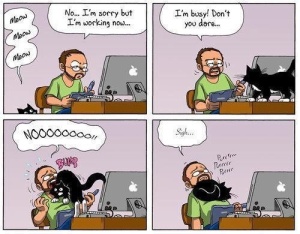
Many people say they skip reading the prologue anyway. Publishers are aware of that, some admit to skipping them too. Some others suggest prologues can be boring – too much exposition packaged together. But – if the prologue is ‘boring’ then I’d say there’s a good chance the rest of the book may be boring also. After all, the prologue is the first few pages – those pages are concentrated on, and rewritten many times by the writer who understands how important those are. If they’re still boring…what chance the rest?
Given this, should we, or shouldn’t we, use prologues?
Well, as much as my response doesn’t really matter, here it is anyway – it depends. Like anything in writing, it all depends. If it’s a prologue, make it interesting – but we should be doing that anyway, surely? If we don’t have one, or a need for one, then we make sure our first few pages are interesting, then we keep them interesting until the end of the book, right?
If Markus Zusak or Alice Sebold had listened to this No No, we would never have had the fantastic and necessary prologues found in ‘The Book Thief’ or ‘The Lovely Bones’.
Questioning a Yes-Yes : Get in late, get out early
 See what I did there? I’m questioning the opposite of a writing no-no this time. Same diff.
See what I did there? I’m questioning the opposite of a writing no-no this time. Same diff.
Get in late, get out early – this is valuable advice, especially for suspense writers. Getting in late heightens the suspense – writers will often drop us into an action scene where the hero faces some peril, upping the tension and stakes. At the opposite end, we are kicked out early, just after the big climax. Of course, sometimes that can become cliched too – Cue the final tiny scene right at the end – the dead evil person isn’t really dead because we see his hand rising out of the lake.
There is a problem with such valuable advice, however. It’s with interpretation. I’ve actually picked up some Big Six (sorry, five now?or four?) publishers’ newest work out to find myself working through the first few pages where a nameless girl is rushing through the forest – being chased by somebody, or rushing towards something. It took me three pages of bookstore browsing before I realised that this was the heroine, and she was both being chased, and rushing to save somebody. A multi-talented heroine/victim.
But I didn’t care. I had no idea who she was, how she’d got there, or whether I was supposed to share her emotions – which basically were of breathlessness and heart-poundings. And I didn’t care who was chasing her, or who she was running to. I had not spent time with her, I was not invested in her as a character. I didn’t even have a name. I was in too late.
What about the No No’s?
I’m not dismissing them. Many writing rules suggestions have valid and expert reasoning behind them. When your editor tells you that you should never have that many characters in one scene again, when your husband tells you he doesn’t appreciate having his name used for a dog that farts all the time, when your publisher tells you he doesn’t take prologues, no matter how good; then that’s that – some valid rules you can’t break. Harken to the no no, and move on. They’ll probably change their mind later on, about that dog-name.
And – learn to give good grammar. That’s part of the craft also, and there are certainly enough no no’s in grammar to keep us occupied. We need to learn these. I need to learn these. Mwah.
The Writer’s Core Habit Pack for Writing No No’s
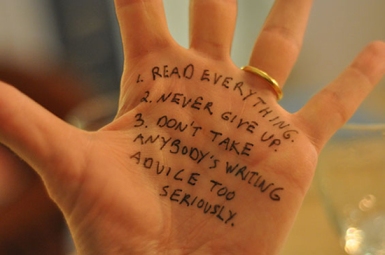
As a successful writer I believe we need to form a core habit around seeking out writing rules – whether “No No”s or “Do This”es – and learning from them – learn what matters, and sometimes break them to fit our story.
Chuck Wendig tells us why in a post 25 Things I want to say to so-called Aspiring Writers (he doesn’t like the term ‘aspiring’ writers either) where he says –
“9. You Need To Learn The Rules. . .in order to know when they must be broken.
10. You Need To Break The Rules. . .in order to know why they matter.
11. What I Mean By Rules Is–
Writing is a technical skill. A craft. You can argue that storytelling is an art. You can argue that art emerges from good writing the way a dolphin riding a jet-ski emerges the longer you stare at a Magic Eye painting. But don’t get ahead of yourself, hoss. You still need to know how to communicate. You need to learn the laws of this maddening land. I’ve seen too many authors want to jump ahead of the skill and just start telling stories — you ever try to get ahead of your own skill level?”
and Neil Gaiman, in his 8 Rules of Writing (via Brain Pickings), says at No. 8 :
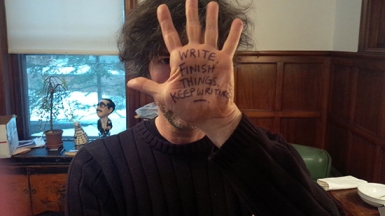
“The main rule of writing is that if you do it with enough assurance and confidence, you’re allowed to do whatever you like. (That may be a rule for life as well as for writing. But it’s definitely true for writing.) So write your story as it needs to be written. Write it honestly, and tell it as best you can. I’m not sure that there are any other rules. Not ones that matter.”
Further Reading:
“Writing isn’t rocket science. It’s not a science of any kind; it’s an art. Science seeks the perfect answer. It wants to classify and quantify, study and label. It seeks precision. It seeks order. Art is not precise. Art is chaos. It is imperfect, flawed, human. Writing is art”. Daniel Dalton. Source.
- Writer’s Digest Online: Writing Rules : 10 Experts Take on the Writer’s Rulebook
- Margaret Lucke – Breaking the Rules of Writing (April 12th, The Ladykillers)
 This blog post participated in April 2013’s Blogging from A to Z Challenge, along with many other blogs on subjects as diverse as writing, foodie blogs or mummy blogs.
This blog post participated in April 2013’s Blogging from A to Z Challenge, along with many other blogs on subjects as diverse as writing, foodie blogs or mummy blogs.
This blog post is part of a themed series or pack on Writer’s Core Habits. I acronym this as WCH or WCHP © . Do a search for these tags, and you will find more in the series.
No affiliate links are used in these posts.
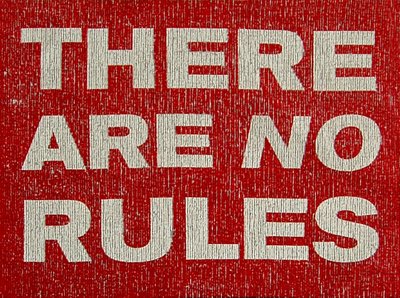
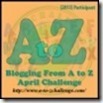

Your posts are filled with action, moving from one discussion or explanation piece to the next, illustrated with graphics, charts and photographs, additional thoughts (your own), quotes (of other writers), and suggested further readings or even bibliographical references. I find every time I go back and reread I learn something else. You are very entertaining. Great work!
Denise at Organization and Inspiration for Fellow Writers, participant of A to Z Blogging Challenge
Denise Reashore on Facebook